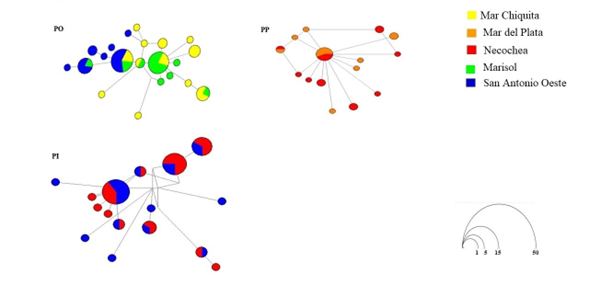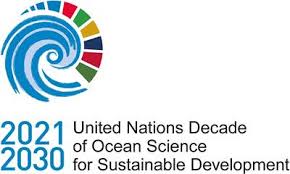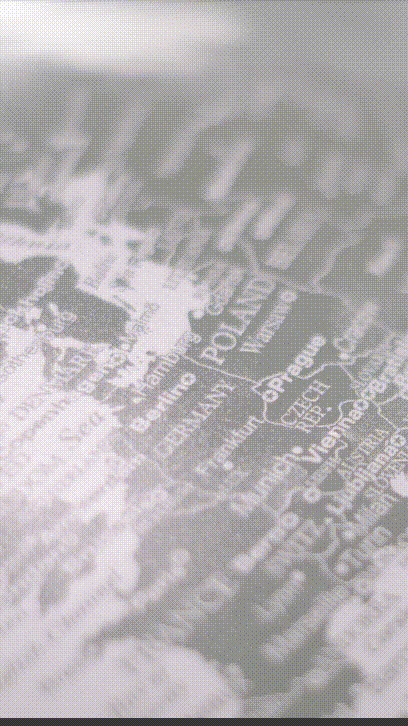Demographic and genetic diversity of the genus Paralichthys in the Buenos Aires Coastal Ecosystem of the southwestern Atlantic
DOI:
https://doi.org/10.47193/mafis.3832025010707Keywords:
Flatfishes, Last Glacial Maximum, life history traits, mitochondrial DNA, PhylogeographyAbstract
Organisms inhabiting the southwestern Atlantic Ocean shelf have undergone significant population changes as a result of climatic fluctuations during the Pleistocene glaciations. These glaciations led to contractions and expansions in population size. This study investigates three coexisting flatfish species particularly within the Buenos Aires Coastal Ecosystem: Paralichthys orbignyanus, P. patagonicus, and P. isosceles. We analyzed haplotypic and nucleotide diversity, as well as demographic trends, across these species using cytochrome b and mitochondrial control region markers. We hypothesized that habitat loss, sea depth, temperature and salinity variations have differently affected the genetic diversity and demographic histories of these flatfish species. Our results revealed notable differences between species inhabiting shallow and deep waters. Those in shallow and coastal waters, such as P. orbignyanus and P. patagonicus, generally exhibited lower genetic diversity, signs of population expansion and shorter coalescence (i.e. common ancestor) times. In contrast, species from deeper waters, like P. isosceles, displayed higher genetic diversity, population stability, and longer coalescence times. Comparative phylogeographic analyses of these species may offer strong evidence supporting hypotheses about the historical impact of the Last Glacial Maximum on coastal habitats and its effects on the habitat preferences of flatfishes within the Buenos Aires Coastal Ecosystem in the southwestern Atlantic Ocean.
Downloads
References
Aboim MA, Menezes GM, Schlitt T, Rogers AD. 2005. Genetic structure and history of populations of the deep‐sea fish Helicolenus dactylopterus (Delaroche, 1809) inferred from mtDNA sequence analysis. Mol Ecol. 14: 1343-1354.
Acha EM, Mianzan HW, Guerrero RA, Favero M, Bava J. 2004. Marine fronts at the continental shelves of austral South America physical and ecological processes. J Mar Syst. 44: 83-105.
Anderson JD, Karel WJ. 2012. Population genetics of southern flounder with implications for management. N Am J Fish. 32: 656-662.
Anderson JD, Karel WJ, Mione ACS. 2012. Population structure and evolutionary history of southern flounder in the Gulf of Mexico and Western Atlantic Ocean. Trans Am Fish Soc. 141: 46-55.
Avise JC. 1992. Molecular population structure and the biogeographic history of a regional fauna: a case history with lessons for conservation biology. Oikos. 3: 62-76.
Avise JC. 2000. Phylogeography: the history and formation of species. Cambridge: Harvard University Press.
Azevedo MF, Oliveira CC, Pardo BG, Martínez P, Foresti F. 2007. Cytogenetic characterization of six species of flatfishes with comments to karyotype differentiation patterns in Pleuronectiformes (Teleostei). J Fish Biol. 70: 1-15.
Balech E, Ehrlich MD. 2008. Esquema biogeográfico del Mar Argentino. Rev Invest Desarr Pesq. 19: 45-75.
Bandelt HJ, Forster P, Röhl A. 1999. Median-joining networks for inferring intraspecific phylogenies. Mol Biol Evol. 16: 37-48.
Barber PH, Cheng SH, Erdmann MV, Tengardjaja K, Ambariyanto A. 2011. Evolution and conservation of marine biodiversity in the Coral Triangle: insights from stomatopod Crustacea. In: Held C, Koenemann S, Schubart CD, editors. Phylogeography and population genetics in Crustacea. CRC Press Publisher. p. 129-156.
Barber PH, Erdmann MV, Palumbi SR. 2006. Comparative phylogeography of three codistributed stomatopods: origins and timing of regional lineage diversification in the coral triangle. Evolution. 60: 1825-1839.
Beheregaray LB, Sunnucks P. 2001. Fine-scale genetic structure, estuarine colonization and incipient speciation in the marine silverside fish Odontesthes argentinensis. Mol Ecol. 10: 2849-2866.
Bowen BW, Gaither MR, Di Battista JD, Iacchei M, Andrews KR, Grant WS, Toonen RJ, Briggs JC. 2016. Comparative phylogeography of the ocean planet. P Natl Acad Sci. 113: 7962-7969.
Bowen BW, Muss A, Rocha LA, Grant WS. 2006. Shallow mtDNA coalescence in Atlantic pygmy angelfishes (genus Centropyge) indicates a recent invasion from the Indian Ocean. J Hered. 97: 1-12.
Bowen BW, Shanker K, Yasuda N, Malay MCMD, von der Heyden S, Paulay G, Rocha LA, Selkoe KA, Barber PH, Williams ST, et al. 2014. Phylogeography unplugged: comparative curveys in the genomic era. B Mar Sci. 90: 13-46.
Cousseau MB, Perrotta, RG. 2013. Peces marinos de Argentina. Biología, distribución, pesca. 4ta ed. Mar del Plata: Instituto Nacional de Investigación y Desarrollo Pesquero (INIDEP). 193 p.
Carpenter KE, Barber PH, Crandall ED, Ablan-Lagman MCA, Ambariyanto G, Mahardika GN, Manjaji-Matsumoto BM, Juinio-Menez MA, Santos MD, Starger CJ, et al. 2011. Comparative phylogeography of the Coral Triangle and implications for marine management. J Mar Sci. 2011: 396982. DOI: https://doi.org/10.1155/2011/396982
Crandall ED, Jones ME, Muñoz MM. 2008. Comparative phylogeography of two seastars and their ectosymbionts within the Coral Triangle. Mol Ecol. 17: 5276-5290.
Díaz de Astarloa JM. 2002. A review of the flatfish fisheries of the South Atlantic Ocean. Rev Biol Mar Oceanog. 37 (2): 113-125.
Díaz de Astarloa JM. 2016. Peces marinos de la costa bonaerense. In: Athor J, Celsi CE, editors. La Costa Atlántica de Buenos Aires. Naturaleza y patrimonio cultural. Fundación de Historia Natural Félix de Azara. p. 399-431.
Díaz de Astarloa JM, Fabré NN. 2003. Abundance of three flatfish species (Pleuronectiformes, Paralichthyidae) off northern Argentina and Uruguay in relation to environmental factors. Arch Fish Mar Res. 50: 123-140.
Díaz de Astarloa JM, Munroe TA. 1998. Systematics, distribution and ecology of commercially important paralichthyid flounders occurring in Argentinean-Uruguayan waters (Paralichthys, Paralichthyidae): an overview. J Sea Res. 39: 1-9.
Drummond AJ, Rambaut A. 2007. BEAST: Bayesian evolutionary analysis by sampling trees. BMC Evol Biol. 7: 1-8.
Drummond AJ, Suchard MA, Xie D, Rambaut A. 2012. Bayesian phylogenetics with BEAUti and the BEAST 1.7. Mol Biol Evol. 29: 1969-1973.
Excoffier L, Lischer HE. 2010. Arlequin suite ver 3.5: a new series of programs to perform population genetics analyses under Linux and Windows. Mol Ecol Res. 10: 564-567.
Fabré NN, Díaz de Astarloa JM. 1996. Pleuronectiformes de importancia comercial del Atlántico Sudoccidental, entre los 34° 30' y 55° S. Distribución y consideraciones sobre su pesca. Rev Invest Desarr Pesq. 10: 45-55.
Fabré NN, Díaz de Astarloa JM. 2001. Distributional patterns and abundance of paralichthyid flounders in the south-west Atlantic (Pleuronectiformes: Paralichthyidae). Thalassas. 17: 45-55.
Fainburg LA, Fernández Iriarte PJ. 2017. Current knowledge on commercially important fish stocks of the Buenos Aires Coastal Ecosystem. Rev Fish Sci Aquac. 26: 176-182.
Fainburg LA, Sabadin D, Díaz de Astarloa JM, Fernández Iriarte PJ. 2022. Population structure of mud flounder Paralichthys orbignyanus from the south-western Atlantic Ocean. J Fish Biol. 102: 455-464.
Fernández Iriarte PJ, González-Wevar CA, Segovia NI, Rosenfeld S, Hüne M, Fainburg LA, Nuñez JD, Haye PA, Poulin E. 2020. Quaternary ice sheets and sea level regression drove divergence in a marine gastropod along eastern and western coasts of South America. Sci Rep. 10: 844. DOI: https://doi.org/10.1038/s41598-020-57543-4
Figueiredo JL, Menezes NA. 2000. Manual de peixes marinhos do sudeste do Brasil. VI. Teleostei (5). Sao Paulo: Museu de Zoologia da Universidade de Sao Paulo. 116 p.
Filatov DA. 2002. ProSeq: a software for preparation and evolutionary analysis of DNA sequence data sets. Mol Ecol Not. 2: 621-624.
Fu YX. 1997. Statistical tests of neutrality of mutations against population growth, hitchhiking and background selection. Genetics. 147: 915-925.
González-Wevar CA, Saucède T, Morley SA, Chown SL, Poulin E. 2013. Extinction and recolonization of maritime Antarctica in the limpet Nacella concinna (Strebel, 1908) during the last glacial cycle: toward a model of quaternary biogeography in shallow Antarctic invertebrates. Mol Ecol. 22: 5221-5236.
Grant W, Bowen BW. 1998. Shallow population histories in deep evolutionary lineages of marine fishes: insights from sardines and anchovies and lessons for conservation. J Hered. 89: 415-426.
Hedgecock D, Pudovkin AI. 2011. Sweepstakes reproductive success in highly fecund marine fish and shellfish: a review and commentary. B Mar Sci. 87: 971-1002.
Ho SYW, Phillips MJ, Cooper A, Drummond AJ. 2005. Time dependency of molecular rate estimated and systematic overestimation of recent divergence times. Mol Biol Evol. 22: 1561-1568.
Isla F. 2012. Highstands of the sea level and the speciation of coastal communities: opportunities for the new territories in southern South America. Bol Biod Chile. 7: 48-62.
Isla F, Madirolas A. 2009. Submerged Pleistocene highstand at the inner shelf of the
Río de la Plata. Thalassas. 25: 21-26.
Ituarte RB, D’Anatro A, Luppi TA, Ribeiro PD, Spivak ED, Iribarne OO, Lessa EP. 2012. Population structure of the SW Atlantic estuarine crab Neohelice granulata throughout its range: a genetic and morphometric study. Estuar Coast. 35 (5): 1249-1260.
Janko K, Lecointre G, DeVries A, Couloux A, Cruaud C, Marshall C. 2007. Did glacial advances during the Pleistocene influence differently the demographic histories of benthic and pelagic Antarctic shelf fishes? Inferences from intraspecific mitochondrial and nuclear DNA sequence diversity. BMC Evol Biol. 1: 207-220.
Larkin MA, Blackshields G, Brown NP, Chenna R, McGettigan PA, McWilliam H, Valentin F, Wallace IM, Wilm A, Lopez R. Thompson JD, et al. 2007. Clustal W and Clustal X version 2.0. Bioinformatics. 23: 2947-2948.
Lee WJ, Conroy J, Howell WH, Kocher TD. 1995. Structure and evolution of teleost mitochondrial control region. J Mol Evol. 41: 54-66.
Librado P, Rozas J. 2009. DnaSP v5: a software for comprehensive analysis of DNA polymorphism data. Bioinformatics. 25 (11): 1451-1452. DOI: https://doi.org/10.1093/bioinformatics/btp187
López Cazorla A. 2005. On the age and growth of flounder Paralichthys orbignyanus (Jenyns, 1842) in Bahía Blanca estuary, Argentina. Hydrobiol. 537: 81-87.
Mabragaña E, Díaz de Astarloa JM, Hanner R, Zhang J, González Castro M. 2011. DNA barcoding identifies Argentine fishes from marine and brackish waters. PLoS ONE 6 (12): e28655. DOI: https://doi.org/10.1371/journal.pone.0028655
Manel S, Guerin PE, Mouillot D, Blanchet S, Velez L, Albouy C, Pellissier L. 2020. Global determinants of freshwater and marine fish genetic diversity. Nat Comm. 11: 692. DOI: https://doi.org/10.1038/s41467-020-14409-7
Milessi AC. 2008. Modelación ecotrófica para el Ecosistema Costero Bonaerense (34°-41°S) años ’81-83. Inf Téc Of INIDEP Nº 8/2008. 55 p.
Martínez AS, Willoughby JR, Christie MR. 2018. Genetic diversity in fishes is influenced by habitat type and life‐history variation. Ecol Evol. 8: 12022-12031.
Munroe TA. 2015. Distributions and biogeography. In: Gibson RN, Nash RDM, Geffen AJ, van der Veer HW, editors. Flatfishes: biology and exploitation. 2nd ed. Wiley. p. 52-82.
Núñez JD, Fernández Iriarte PJ, Ocampo EH, Iudica C, Cledón M. 2015. Deep phylogeographic divergence among populations of limpet Siphonaria lessoni on the east and west coasts of South America. Mar Biol. 162: 595-605.
Piola AR, Matano RP. 2001. Brazil and Falklands (Malvinas) currents. In: Steele JH, SA Thorpe, Turekian KK, editors. Encyclopedia of ocean sciences. 1. London: Academic Press. p. 340-349.
Ponce JF, Rabassa J, Coronato A, Borromei AM. 2011. Palaeogeographical evolution of the Atlantic coast of Pampa and Patagonia from the last glacial maximum to the middle Holocene. Biol J Linn Soc. 103: 363-379.
Posada D. 2008. jModelTest: phylogenetic model averaging. Mol Biol Evol. 25: 1253-1256.
Rabassa J. 2008. Late cenozoic glaciations in Patagonia and Tierra del Fuego. Dev Quat Sci. 11: 151-204.
Rabassa J, Coronato AM, Salemme M. 2005. Chronology of the late Cenozoic Patagonian glaciations and their correlation with biostratigraphic units of the Pampean region (Argentina). J S Am Earth Sci. 20: 81-103.
Ramos Onsins SE, Rozas J. 2002. Statistical properties of new neutrality test against population growth. Mol Biol Evol. 19: 2092-2100.
Reiss H, Hoarau G, Dickey-Collas M, Wolff WJ. 2009. Genetic population structure of marine fish: mismatch between biological and fisheries management units. Fish Fisher. 10: 361-395.
Rico MR. 2010. Pesquería de lenguados en el ecosistema costero bonaerense al norte de 39° S. Frente Marít. 21: 129-135.
Rico MR, Lagos AN. 2009. Lenguados del sistema costero bonaerense. Herramientas para la identificación de especies. Inf Téc Of INIDEP Nº 58/2009. 15 p.
Rico MR, Lagos AN, García S. 2011. Otros recursos costeros de Argentina, avances y perspectivas. Frente Marít. 22: 45-70.
Riestra CM, Díaz de Astarloa JM, Vieira JP, Buratti C, Irigoyen A, Landaeta M, Hüne, M. 2020a. Paralichthys orbignyanus. The IUCN Red List of Threatened Species. DOI: https://doi.org/10.2305/iucn.uk.2020-2.rlts.t195088a165017950.en
Riestra CM, Díaz de Astarloa JM, Vieira JP, Buratti C, Irigoyen A, Landaeta M, Hüne M. 2020b. Paralichthys patagonicus. The IUCN Red List of Threatened Species. DOI: https://doi.org/10.2305/iucn.uk.2020-1.rlts.t195089a165017727.en
Riestra CM, Díaz de Astarloa J, Vieira JP, Buratti C, Irigoyen A, Landaeta M, Hüne M. 2020c. Paralichthys isosceles. The IUCN Red List of Threatened Species. DOI: https://doi.org/10.2305/iucn.uk.2020-2.rlts.t195087a165017890.en
Rogers AR, Harpending H. 1992. Population growth makes waves in the distribution of pairwise population differences. Mol Biol Evol. 9: 552-569.
Roy D, Hurlbut TR, Ruzzante DE. 2012. Biocomplexity in a demersal exploited fish, white hake (Urophycis tenuis): depth-related structure and inadequacy of current management approaches. Can J Fish Aquat Sci. 69: 415-429.
Ruzzante DE, Walde SJ, Gosse JC, Cussac VE, Habit E, Zemlak TS, Adams ED. 2008. Climate control on ancestral population dynamics: Insight from Patagonian fish phylogeography. Mol Ecol. 17: 2234-2244.
Selkoe KA, D’Aloia CC, Crandall ED, Iacchei M, Liggins L, Puritz JB, von der Heyden S, Toonen RJ. 2016. A decade of seascape genetics: contributions to basic and applied marine connectivity. Mar Ecol Prog Ser. 554: 1-19.
Sérsic AN, Cosacov A, Cocucci AA, Johnson LA, Pozner R, Avila LJ. 2011. Phylogeographical patterns of plants and terrestrial vertebrates from Patagonia. Biol J Linn Soc. 103: 475-494.
Shigenobu Y, Yoneda M, Kurita Y, Ambe D, Saitoh K. 2013. Population subdivision of Japanese flounder Paralichthys olivaceus in the Pacific coast of Tohoku Japan detected by means of mitochondrial phylogenetic information. Int J Mol Sci. 14: 954-963.
Spalding MD, Fox H, Allen GR, Davidson N, Ferdaña ZA, Finlayson M, Halpern BS, Jorge MA, Lombana Al, Lourie SA, et al. 2007. Marine ecoregions of the world: a bioregionalization of coastal and shelf areas. Bioscience. 57: 573-583.
Sun CH, Yang F, Huang Qi, Zeng XS, Zhan YN, Li Y, Yu JF, Zhang Q. 2022. Genetic population structure and demographic history of the endemic fish Paralichthys olivaceus of the Northwest Pacific Ocean. Ecol Evol. 12: 1-11.
Tajima F. 1983. Evolutionary relationship of ADN sequences in finite populations. Genetics. 105: 437-460.
Toonen RJ, Andrews KR, Baums IB, Bird CE, Conception GT, Daly-Engel TS, Eble JA, Faucci A, Gaither MR, Iacchei M, et al. 2011. Defining boundaries for ecosystem-based management: a multispecies case study of marine connectivity across the Hawaiian archipelago. J Mar Biol. 1: 1-13.
Vandamme S, Raeymaekers JA, Maes GE, Cottenie K, Calboli FC, Diopere E, Volckaert FA. 2020. Reconciling seascape genetics and fisheries science in three codistributed flatfishes. Evol Appl. 14: 536-552.
Walsh SJ, Díaz de Astarloa JM, Poos JJ. 2015. Atlantic flatfish fisheries. In: Gibson RN, Nash RDM, Geffen AJ, van der Veer HW, editors. Flatfishes: biology and exploitation. Hoboken: Wiley-Blackwell. p. 52-82.
Wang VH, McCartney MA, Scharf FS. 2015. Population genetic structure of southern flounder inferred from multilocus DNA profiles. Mar Coast Fish. 7: 220-232.
Winemiller KO, Rose KA. 1992. Patterns of life-history diversification in North American fishes: implications for population regulation. Can J Fish Aquat Sci. 49: 2196-2218.

Published
Issue
Section
License
Copyright (c) 2025 Leandro A. Fainburg, David E. Sabadin, Juan M. Díaz de Astarloa, Pedro Fernández Iriarte

This work is licensed under a Creative Commons Attribution-NonCommercial-ShareAlike 4.0 International License.
Authors of articles published in Marine and Fishery Sciences retain copyright on their articles, except for any third-party images and other materials added by Marine and Fishery Sciences, which are subject to copyright of their respective owners. Authors are therefore free to disseminate and re-publish their articles, subject to any requirements of third-party copyright owners and subject to the original publication being fully cited. Visitors may also download and forward articles subject to the citation requirements. The ability to copy, download, forward or otherwise distribute any materials is always subject to any copyright notices displayed. Copyright notices must be displayed prominently and may not be obliterated, deleted or hidden, totally or partially.
This journal offers authors an Open Access policy. Users are allowed to read, download, copy, distribute, print, search, or link to the full texts of the articles, or use them for any other legal purpose within the Creative Commons 4.0 license (BY-NC-SA), without asking prior permission from the publisher or the author. This is in accordance with the BOAI definition of Open Access.























